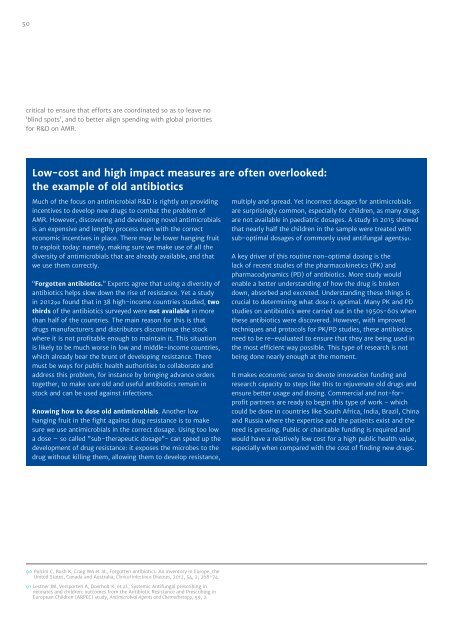TACKLING DRUG-RESISTANT INFECTIONS GLOBALLY FINAL REPORT AND RECOMMENDATIONS
qQvJ300ETXu
qQvJ300ETXu
You also want an ePaper? Increase the reach of your titles
YUMPU automatically turns print PDFs into web optimized ePapers that Google loves.
50<br />
critical to ensure that efforts are coordinated so as to leave no<br />
‘blind spots’, and to better align spending with global priorities<br />
for R&D on AMR.<br />
Low-cost and high impact measures are often overlooked:<br />
the example of old antibiotics<br />
Much of the focus on antimicrobial R&D is rightly on providing<br />
incentives to develop new drugs to combat the problem of<br />
AMR. However, discovering and developing novel antimicrobials<br />
is an expensive and lengthy process even with the correct<br />
economic incentives in place. There may be lower hanging fruit<br />
to exploit today: namely, making sure we make use of all the<br />
diversity of antimicrobials that are already available, and that<br />
we use them correctly.<br />
“Forgotten antibiotics.” Experts agree that using a diversity of<br />
antibiotics helps slow down the rise of resistance. Yet a study<br />
in 201290 found that in 38 high-income countries studied, two<br />
thirds of the antibiotics surveyed were not available in more<br />
than half of the countries. The main reason for this is that<br />
drugs manufacturers and distributors discontinue the stock<br />
where it is not profitable enough to maintain it. This situation<br />
is likely to be much worse in low and middle-income countries,<br />
which already bear the brunt of developing resistance. There<br />
must be ways for public health authorities to collaborate and<br />
address this problem, for instance by bringing advance orders<br />
together, to make sure old and useful antibiotics remain in<br />
stock and can be used against infections.<br />
Knowing how to dose old antimicrobials. Another low<br />
hanging fruit in the fight against drug resistance is to make<br />
sure we use antimicrobials in the correct dosage. Using too low<br />
a dose – so called "sub-therapeutic dosage”- can speed up the<br />
development of drug resistance: it exposes the microbes to the<br />
drug without killing them, allowing them to develop resistance,<br />
multiply and spread. Yet incorrect dosages for antimicrobials<br />
are surprisingly common, especially for children, as many drugs<br />
are not available in paediatric dosages. A study in 2015 showed<br />
that nearly half the children in the sample were treated with<br />
sub-optimal dosages of commonly used antifungal agents91.<br />
A key driver of this routine non-optimal dosing is the<br />
lack of recent studies of the pharmacokinetics (PK) and<br />
pharmacodynamics (PD) of antibiotics. More study would<br />
enable a better understanding of how the drug is broken<br />
down, absorbed and excreted. Understanding these things is<br />
crucial to determining what dose is optimal. Many PK and PD<br />
studies on antibiotics were carried out in the 1950s-60s when<br />
these antibiotics were discovered. However, with improved<br />
techniques and protocols for PK/PD studies, these antibiotics<br />
need to be re-evaluated to ensure that they are being used in<br />
the most efficient way possible. This type of research is not<br />
being done nearly enough at the moment.<br />
It makes economic sense to devote innovation funding and<br />
research capacity to steps like this to rejuvenate old drugs and<br />
ensure better usage and dosing. Commercial and not-forprofit<br />
partners are ready to begin this type of work - which<br />
could be done in countries like South Africa, India, Brazil, China<br />
and Russia where the expertise and the patients exist and the<br />
need is pressing. Public or charitable funding is required and<br />
would have a relatively low cost for a high public health value,<br />
especially when compared with the cost of finding new drugs.<br />
90 Pulcini C, Bush K, Craig WA et al., Forgotten antibiotics: An inventory in Europe, the<br />
United States, Canada and Australia, Clinical Infectious Diseases, 2012, 54, 2, 268-74.<br />
91 Lestner JM, Versporten A, Doerholt K, et al., Systemic Antifungal prescribing in<br />
neonates and children: outcomes from the Antibiotic Resistance and Prescribing in<br />
European Children (ARPEC) study, Antimicrobial Agents and Chemotherapy, 59, 2.


